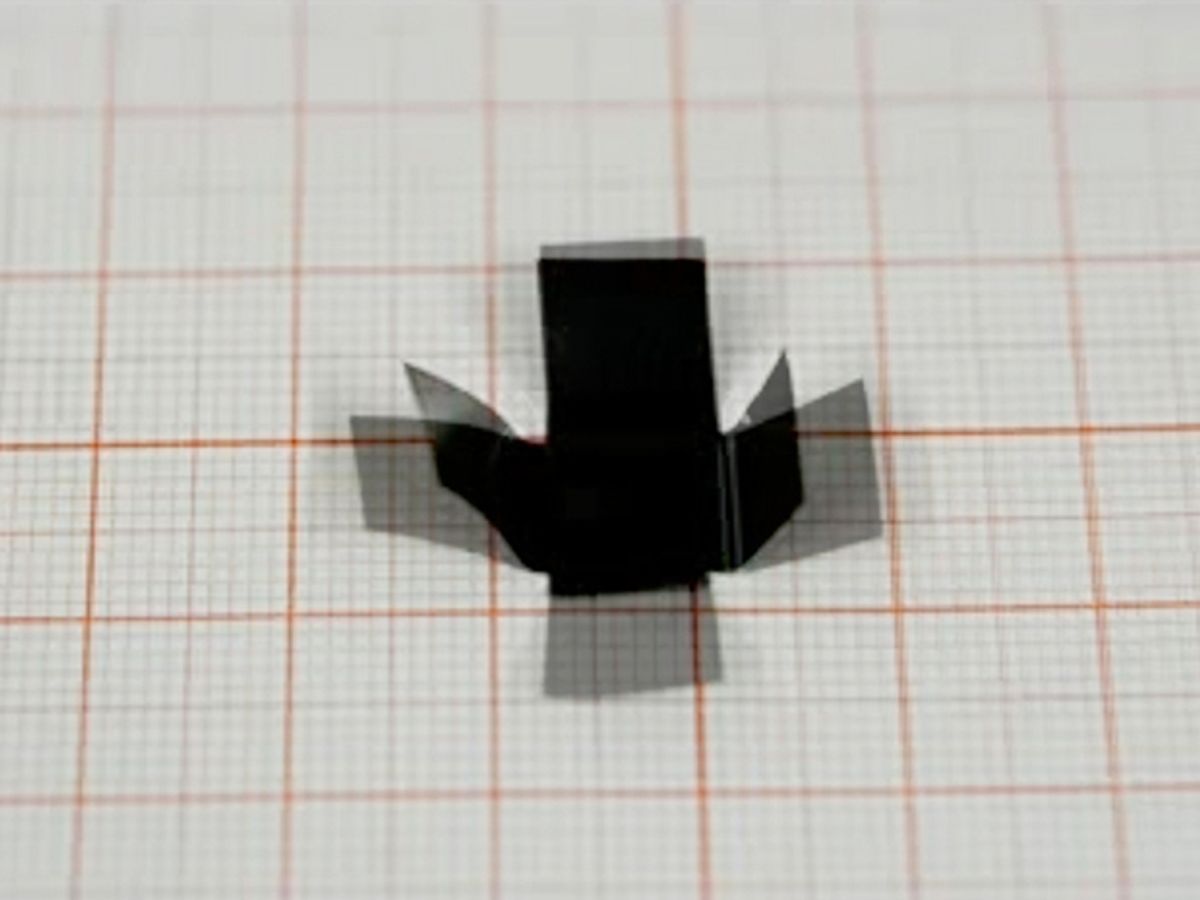A tiny sheet of graphene “paper” smaller than a human fingernail can behave like an origami robot that folds and walks on command. The inspired work by Chinese researchers could pave the way for such self-folding devices as tiny robots and artificial muscles, or even help with biological tissue engineering on the smallest scales.
Demonstrations of the origami bots included graphene paper scooting across a surface like an inchworm, a tiny self-folding box, and a small graphene hand engineered with knuckle joints so that it could grasp an object. All the graphene paper movement was activated by either laser light or heat that triggered contractions in certain parts of the graphene sheet, say the Donghua University team that animated the strips of carbon. They detailed their efforts in a paper published in the 6 November 2015 online issue of the journal Science Advances.
“The bending behavior of this paper is programmable so that we can use it to make this device walk and turn—and fold into designed shapes—simply remote-controlled by gentle light or heat,” said Hongzhi Wang, a materials scientist and engineer at Donghua University.
Other researchers have demonstrated similar examples of self-folding devices based on certain types of polymers. But Wang and his colleagues chose to fashion their origami-inspired devices from graphene, reasoning that the resulting objects would be stronger and more versatile compared with traditional polymer materials.
The self-folding actions of the paper depended on differences between two types of graphene. The first material was a graphene oxide (rGO) sheet that doesn’t react to water. The second material, graphene oxide-polydopamine (GO-PDA), can adsorb and desorb water depending on the outside humidity, temperature, or light.
By bonding together layers of the two materials, the Chinese team created the self-folding devices that reacted to laser light or heat. Left unmolested, the GO-PDA layers would remain flat because they were swollen with water molecules. But when light or heat was applied, the GO-PDA layers would release the water molecules, causing it to shrink and forcing the layers of rGO that formed the rest of the graphene paper to bend. That simple mechanism enabled the team to build the equivalent of hinges or joints to make “programmable” graphene devices that responded predictably to light or heat.
“We thought it would be more interesting that an origami device not only folds itself, but also can move on its own, like an origami crane can fly or an origami dragon can walk,” Wang said. “This would be an embryo of a novel kind of robot, in our opinion.”
It took barely 200 milliseconds for the sheet programmed to become a box to respond to near-infrared laser light and begin folding up. In one demonstration, with the light set at an intensity of 100 milliwatts per square centimeter, the sheet transformed itself into a box, measuring about 3 centimeters long on each side, in about 2.6 seconds. When the light was turned off, the box unfolded and lay flat again in a little over 13 seconds.
A second demonstration turned a 1-by-0.8-centimeter sheet of graphene paper into a wormlike robot capable of inching along or even turning. Three GO-PDA lines of different thicknesses acted as the joints that contracted under exposure to light and allowed the graphene paper to move. The Donghua researchers also figured out how to make the wormlike robot turn by shining the light on just one side of the graphene paper.
A third demonstration was the creation of a graphene “hand.” The researchers used the 4-by-6-centimeter hand like a grasping claw that showed the strength of its grip by maintaining its hold on an object. During a separate demonstration, another handlike graphene paper strip was able to lift a 120-milligram load of titanium foil by 7 millimeters in just over 3 seconds.
That lifting demonstration was powered by a laser with set at an intensity of 200 mW/cm2. But the study showed that researchers could change and potentially boost the performance of the graphene paper devices by using different levels of laser irradiation.
The Chinese researchers still hope to improve the energy conversion efficiency of the graphene devices with an eye toward future practical applications. Wang envisions such work aiding “development of next-generation industrial mechanical actuators” and leading to new types of remotely-controlled microrobots, microfluidic chemical analysis, tissue engineering, and artificial muscles.
Such material science experimentation could also point the way toward “smart clothing” capable of changing shape or style in response to factors such as body temperature or environmental changes. Another possibility might be self-folding solar panels and other devices with self-adaptive capabilities that materially respond to changes in their environment.
For now, Wang and his colleagues also want to test what happens when they make even smaller versions of the graphene paper devices. That could lead to future origami demonstrations on scales smaller than the width of a human hair.
“We think that as the device scales down in size, especially to nanoscale, its properties and origami performance would change significantly,” Wang said. “Therefore we are also interested in developing a nano-sized, all-graphene origami device.”
Jeremy Hsu has been working as a science and technology journalist in New York City since 2008. He has written on subjects as diverse as supercomputing and wearable electronics for IEEE Spectrum. When he’s not trying to wrap his head around the latest quantum computing news for Spectrum, he also contributes to a variety of publications such as Scientific American, Discover, Popular Science, and others. He is a graduate of New York University’s Science, Health & Environmental Reporting Program.



